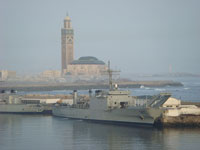 Casablanca OverviewJust looking at the city, there's no need to guess where the
port-city of Casablanca, meaning 'white house' in Spanish, got its
name. Made famous by the classic 1942 Humphrey Bogart movie
, this cosmopolitan, white-walled city is
Morocco's largest and probably its least endearing; although under
the hustle and bustle and slight seediness, lies a unique and
charismatic history waiting to be discovered. Founded by Berber
fisherman in the 10th century BC, Casablanca was used by the
Phoenicians, Romans and Merenids as a port. The Portuguese then
took over but after destroying the city and rebuilding it, they
abandoned it in 1755 after an earthquake. The city went on to be
rebuilt as
(the Arabic name) by a Moroccan sultan, and was
given the name Casablanca by the Spanish traders who used the port.
Casablanca is unlike any other Moroccan city. Women ditch the
conservative clothing and dress themselves in the latest designer
gear, while men flirt shamelessly with them. And while this trend
toward modernity has worked out for some, it has also had some very
negative effects on Casablanca - widespread urban poverty has led
to crime, drugs and prostitution, and evidence of this can be seen
in the slums on the outskirts of the city. A trip to Casablanca -
untraditional and plain as this city may be - is a must for anyone
wanting to experience the 'full picture' of what contemporary
Morocco has to offer. |